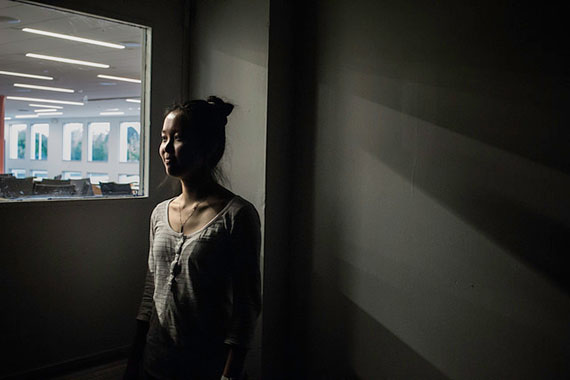The options that a photographer has to light a person’s face and body are many. You may use different types of lights such as parabolic or diffused and you may position them in endless combinations. There are however, five basic set ups that photographers use over and over again, the Rembrandt, the split lighting, the broad lighting, the butterfly lighting and the loop lighting. Here we will describe each one, break down the set ups and give you tips on how to apply them in the optimal manner.

Photo by Vivi Barros
Rembrandt Lighting
This lighting set up is named after the famous Dutch painter who was famous for his low key and high contrast lighting style. This is also a great lighting set up for beginner photographers who don’t have many lights yet in their studios. The reason is, you basically only need one light or two for this set up as it doesn’t use any shadow fill or just a little. It is a simple one light set up that creates a chiaroscuro effect with only one side of the face well lit and a small triangle of light on the other side.
To set up a Rembrandt lighting set up, first place a key light at about 45 degrees from your subject and slightly above the subject’s head. As the subject faces the camera, if you position the light at the right angle, you should see the small triangle of light on the opposite side of the subject’s face. Make sure the triangle of light is not too big and doesn’t pass the length and width of the eye and nose. If it does, adjust the light accordingly. Now that you have a nice contrasty image, it’s time to think about the fill. The point of this set up is to go easy on the fill, or even avoid it. However, that depends first of all on what type of key light you are using and also your style, how much you want to push the chiaroscuro effect. Many photographers use just a reflector or bounce to gently fill the shadows but some photographers also just like to use a smaller and softer lighting fixture. So, move your lights around and try different looks but remember, this set up is about achieving a dramatic look and keeping it simple.
Split Lighting
Split lighting is similar to Rembrandt type of lighting but even more dramatic. Another term used for this type of lighting is “side lighting”, used a lot in film noir cinematography. To achieve this look, just place your main light all the way to the side of your subject. The image will have one side well lit and the opposite in shadow. Then it’s up to you how much you want to add detail to the shadows. Just place a second light to the opposite side of lit area of the subject’s face and adjust the distance.
By placing the fill far away from the subject, you’ll be able to add just the right amount of the detail. If you place the light too close, then you’ll end up losing the side lighting effect. You may also add a background light and aim it to your background. This will help separate the subject from your background and will give you a three dimensional image.
Broad Light
With this set up you don’t really need to change the position of your lights much, compared to Rembrandt or split lighting. The reason it is called “broad light” style, is because the longer side of the subject’s face is lit. All you need to do is to have your subject face away from the light, which most of the times is positioned at 45 degrees from the subject. The subject’s chin, however, will turn to the opposite direction from the light, therefore the subject’s face from his/her nose to his/her ear will be well lit. So, is very easy to go from Rembrandt style to broad light style by just moving the position of the subject.
Also, remember you may have the subject’s face in broad light style but have the body in Rembrandt style by just having the body face away from the light. If, on the other hand, the body faces the light, then it will be broadly lit.
Butterfly Light
This type of lighting is also called “Paramount Lighting” because it was popular back in the 1930s in Hollywood. And the reason is called “Butterfly light” is because the light is positioned right in front the subject but at a steep angle facing down, therefore creating a shadow right underneath the subject’s nose that resembles a butterfly. The recommended angle is usually between 25 and 70 degrees.
It is considered a beauty lighting set up, mostly for women, and also it works best with people with pronounced cheekbones and a lean figure as slight shadows are created right below the cheekbones. Also remember you may position a bounce board below the subject as a fill. This will give a beautiful glow to the subject’s face.
Loop Light
The loop light style is just a slight variation from the Paramount light. All you have to do is move the light to one side, usually to the right of the camera, but still have it at a high angle. This style, because of the shadows it creates, gives a sense of depth that other styles don’t have. The reason is called looped lighting is because of the shadow that is created under and to the side of the nose that is loop-shaped.
So now you have it. These are the most used lighting set ups for portraits. The more dramatic Rembrandt and split lighting, the more flattering broad light, and the beauty shots Paramount and loop lights. Too many choices? Well, always remember, find your style, try them out on different subjects. The more and more you practice you’ll also discover that most of the times the best style is the one that suits the subject the best. Every person has something in their features that makes them stand out. Choose the right lighting for each person so that you enhance those features and you’ll always get those beauty shots!
About the Author:
Mattias Falco writes for Lighting Rental Los Angeles, a rental shop located in the heart of Hollywood.
Go to full article: Portrait Photography Lighting: The 5 Classical Types
What are your thoughts on this article? Join the discussion on Facebook
PictureCorrect subscribers can also learn more today with our #1 bestseller: The Photography Tutorial eBook
The post Portrait Photography Lighting: The 5 Classical Types appeared first on PictureCorrect.
from PictureCorrect https://ift.tt/2TAYJCk
via IFTTT







0 comments:
Post a Comment